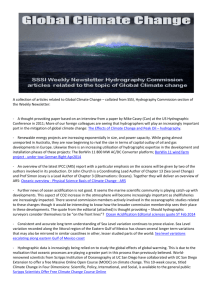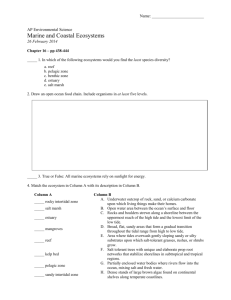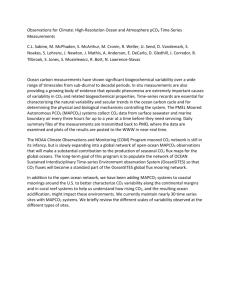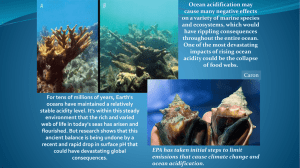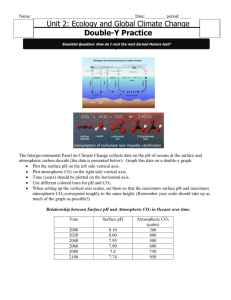CariCoos Ocean Acidification Product Background Rising levels of
advertisement
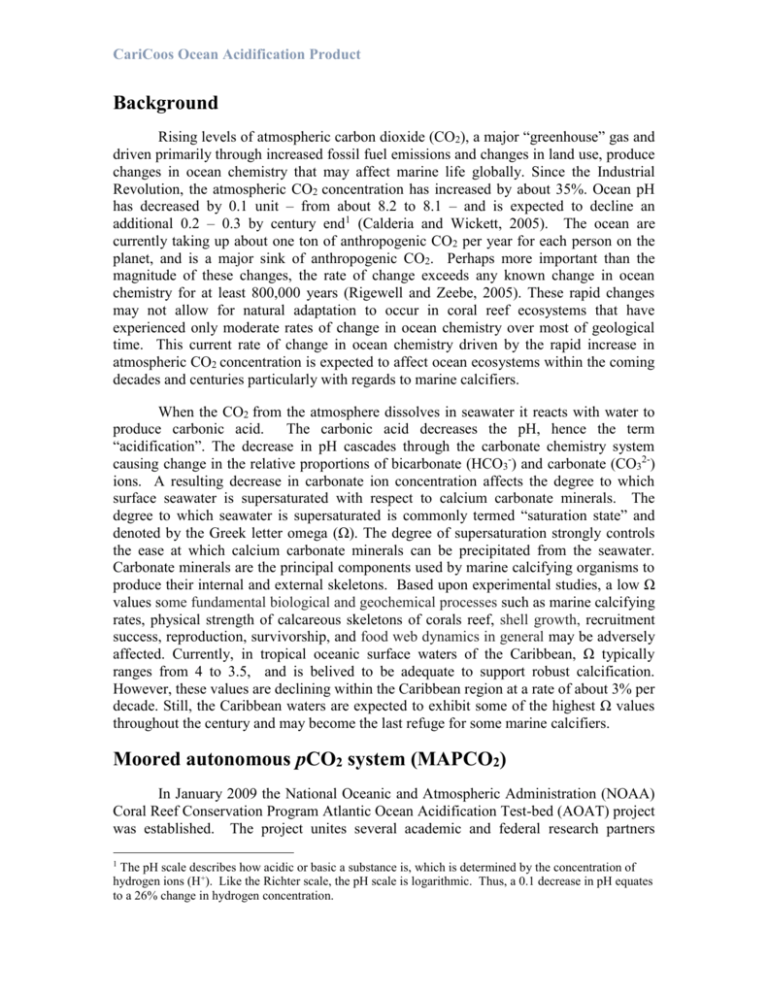
CariCoos Ocean Acidification Product Background Rising levels of atmospheric carbon dioxide (CO2), a major “greenhouse” gas and driven primarily through increased fossil fuel emissions and changes in land use, produce changes in ocean chemistry that may affect marine life globally. Since the Industrial Revolution, the atmospheric CO2 concentration has increased by about 35%. Ocean pH has decreased by 0.1 unit – from about 8.2 to 8.1 – and is expected to decline an additional 0.2 – 0.3 by century end1 (Calderia and Wickett, 2005). The ocean are currently taking up about one ton of anthropogenic CO2 per year for each person on the planet, and is a major sink of anthropogenic CO2. Perhaps more important than the magnitude of these changes, the rate of change exceeds any known change in ocean chemistry for at least 800,000 years (Rigewell and Zeebe, 2005). These rapid changes may not allow for natural adaptation to occur in coral reef ecosystems that have experienced only moderate rates of change in ocean chemistry over most of geological time. This current rate of change in ocean chemistry driven by the rapid increase in atmospheric CO2 concentration is expected to affect ocean ecosystems within the coming decades and centuries particularly with regards to marine calcifiers. When the CO2 from the atmosphere dissolves in seawater it reacts with water to produce carbonic acid. The carbonic acid decreases the pH, hence the term “acidification”. The decrease in pH cascades through the carbonate chemistry system causing change in the relative proportions of bicarbonate (HCO3-) and carbonate (CO32-) ions. A resulting decrease in carbonate ion concentration affects the degree to which surface seawater is supersaturated with respect to calcium carbonate minerals. The degree to which seawater is supersaturated is commonly termed “saturation state” and denoted by the Greek letter omega (Ω). The degree of supersaturation strongly controls the ease at which calcium carbonate minerals can be precipitated from the seawater. Carbonate minerals are the principal components used by marine calcifying organisms to produce their internal and external skeletons. Based upon experimental studies, a low Ω values some fundamental biological and geochemical processes such as marine calcifying rates, physical strength of calcareous skeletons of corals reef, shell growth, recruitment success, reproduction, survivorship, and food web dynamics in general may be adversely affected. Currently, in tropical oceanic surface waters of the Caribbean, Ω typically ranges from 4 to 3.5, and is belived to be adequate to support robust calcification. However, these values are declining within the Caribbean region at a rate of about 3% per decade. Still, the Caribbean waters are expected to exhibit some of the highest Ω values throughout the century and may become the last refuge for some marine calcifiers. Moored autonomous pCO2 system (MAPCO2) In January 2009 the National Oceanic and Atmospheric Administration (NOAA) Coral Reef Conservation Program Atlantic Ocean Acidification Test-bed (AOAT) project was established. The project unites several academic and federal research partners 1 The pH scale describes how acidic or basic a substance is, which is determined by the concentration of hydrogen ions (H+). Like the Richter scale, the pH scale is logarithmic. Thus, a 0.1 decrease in pH equates to a 26% change in hydrogen concentration. CariCoos Ocean Acidification Product including University of Puerto Rico, Mayagüez Campus (UPRM), University of Miami, Columbia University, Woods Hole Oceanographic Institution (WHOI), the Atlantic Oceanographic and Meteorological Laboratory (AOML), and the Pacific Marine Environmental Laboratory (PMEL). As a key part of this project, a moored autonomous pCO2 system (MAPCO2) was deployed along the forereef of the Cayo Enrique shelf reef at La Parguera, Puerto Rico. A suite of chemical, physical, and meteorological measurements monitored within the La Parguera Marine Reserve are used to track the dynamics and controls on local carbon chemistry at the site. The autonomous capabilities MAPCO2 buoy which provides continuous 3 hourly measurements of both air and sea mole fraction CO2 along with temperature, salinity, and dissolved oxygen. The data are transmitted daily for quality control by NOAA PMEL (http://pmel.noaa.gov/co2/story/La+Parguera). These data are than routinely merged with oceanographic and meteorological data available from the nearby NOAA ICON/CREWS station. These autonomous observations are validated and supplemented on a weekly basis through a discrete sampling campaign conducted by the people of the chemical oceanography lab and CariCoos at Marine Science Department of UPRM. This campaign includes a CTD and water sample transect along the Cayo Enrique forereef, at the MAPCO2, and 0.5 km up-current from the forereef. Water samples are immediately processed at the nearby UPRM lab for total alkalinity (AT) and spectrophotometric pH. This represents the base for an Ocean Acidification time series in Puerto Rico and has served as an important resource for monitoring carbonate chemistry dynamics across the coral reef ecosystems within the reserve. A simple empirical fit relating changes in discretely measured salinity (S) and temperature (T) to alkalinity is applied to fully constrain the carbonic acid system from the autonomous MAPCO2 data (pCO2,aq, T, S). The CO2 system is solved using the program CO2SYS from Lewis and Wallace (1998) and adapted to Excel by Pierrot et al. (2006) applying the dissociation constants for K1 and K2 of Mehrbach (1973) reformulated by Dickson and Millero (1987), and for KHSO4- from Dickson (1990). The solubility constant used to derive Ωarg is from Mucci (1983). Using this approach, good agreement is found between Ωarg-values obtained through discrete measurements as compared with those obtained by empirical means. CariCoos Ocean Acidification Product The moored autonomous pCO2 system (MAPCO2) deployed at the Cayo Enrique shelf reef provides continuous 3 hourly measurements of both air and sea mole fraction CO2 along with temperature, salinity, and dissolved oxygen. CariCoos Ocean Acidification Product Times Series Annual cycles of practical salinity and temperature off La Parguera. During the summer the temperature at the fore reef was above the 30˚C threshold value for coral bleaching. Salinity values decrease during the summer due to the influx of the Orinoco plume into the eastern Caribbean basin and seasonal precipitation. CariCoos Ocean Acidification Product Annual seawater carbonate saturation state (Ω) with respect to aragonite mineral phase off La Parguera. Maximum and minimum peaks are in April and September for saturation state. Although the seawater carbonate saturation state remains supersaturate (Ω >1) with respect to aragonite mineral phase in La Parguera, we observed “low” values during the fall season at the inshore. Various carbonate saturation state levels were defined by Guinotte et al. (2003) and others, as thresholds values. Marine surface waters with a ΩArg > 4 are categorized as “optimal”, form 3.5 to 4 are “adequate”, from 3.5 to 3and are “low”, and <3 are ‘‘extremely marginal’’. The black dots represent the data computed from MapCO2 buoy. The blue crosses are UPRM discrete samples at the near reef platform. The purple circles represent the UPRM discrete samples at the offshore reef platform. Spectrophotometric pH values off La Parguera. The pH values ranges from 7.9 to 8.1 and the minimum values are on summer time. The pH scale describes how acidic or basic a substance is. To have an idea the pH of the pure water is of about 7 this is what we call CariCoos Ocean Acidification Product the neutral value. Above the neutral value we said that the substance is alkaline or base and below 7 we said that is acid. The ocean pH has decreased by 0.1 units from 1800 to present time. If we continue as business as usual CO2 scenario the pH is expected to decline an additional 0.2 – 0.3 by century end. The black dots represent the data computed from MapCO2 buoy. The blue crosses are UPRM discrete samples at the near reef platform. The purple circles represent the UPRM discrete samples at the offshore reef platform. Dis crete measurements of Total Alkalinity (AT) off La Parguera. The rain precipitation and the contribution of freshwater from Orinoco River during the months of June through September causes a decrease in salinity and therefore the AT decrease as well. The future precipitation events due to the negative effects of climate change could have a significant effect on AT and as consequence on the carbonate chemistry in the Caribbean Region. The black dots represent the data computed from MapCO2 buoy. The blue crosses are UPRM discrete samples at the near reef platform. The purple circles represent the UPRM discrete samples at the offshore reef platform. The Flux of CO2 indicates that the reef community metabolism of Cayo Enrique (like most other reefs) serves as a net source of CO2 to the atmosphere. CariCoos Ocean Acidification Product More details of the Real Time MAPCO2 Data in: Pacific Marine Environmental Laboratory (PMEL) http://www.pmel.noaa.gov/co2/story/La+Parguera Coral Reef Early Warning System (CREWS) http://www.coral.noaa.gov/data/icon-network/crews-network.html Coral Reef Watch www.coralreefwatch.noaa.gov/satellite/oa/ Dwight Gledhill dwight.gledhill@noaa.gov Melissa Meléndez melissa.melendezoyola@upr.edu
